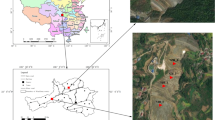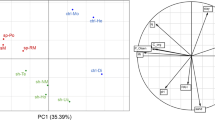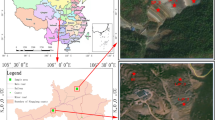Abstract
Bacteria play a vital role in ecological processes of soil contaminated by heavy metals. Here, soil sampling was carried out around a tailings pile contaminated to different degrees by cadmium (Cd), lead (Pb) and arsenic (As). The bacteria in the soil were cultured, separated and purified on Luria–Bertani medium, and the changes in bacterial communities in soils with different pollution levels were analysed with 16S rRNA sequencing. Bacillus pacificus strain MZ520364 was found to be highly tolerant to Cd, Pb and As, and single-metal and multimetal tolerance experiments were further conducted with this strain. The results obtained from alpha diversity and operational taxonomic unit (OTU) statistical analyses showed a significant difference in bacterial composition among soils with different metal pollution levels, and the highest bacterial diversity was found at the most severely polluted site. Evidence from variance partitioning analysis (VPA) and the Spearman correlation heatmap analysis showed that the leading factors affecting bacterial community composition were cation exchange content (CEC), pH, total Zn, total As, and available As concentrations in soil. Additionally, in the single-metal treatments, B. pacificus MZ520364 could tolerate 600 mg/L Cd2+, 1000 mg/L Pb2+ or 700 mg/L As3+. When Cd, Pb and As coexisted, the best growth of B. pacificus MZ520364 was present at 120 mg/L Cd2+, 200 mg/L Pb2+ and 150 mg/L As3+. The effect of Cd, Pb and As on the growth of the strain followed the order of Cd > As > Pb, and the heavy metal combination showed more toxicity than single metals. In summary, our results revealed the ecological impact of soil physicochemical properties on the diversity and richness of soil bacterial communities and suggested that B. pacificus MZ520364 may be used for the remediation of Cd–Pb–As co-contaminated soil.







Similar content being viewed by others
Data availability
The datasets used and analysed during the current study are available from the corresponding author on reasonable request. All data generated or analysed during this study are included in this published article.
References
Ahmad I, Akhtar MJ, Asghar HN, Ghafoor U, Shahid M (2016) Differential effects of plant growth-promoting rhizobacteria on maize growth and cadmium uptake. J Plant Growth Regul 35(2):303–315. https://doi.org/10.1007/s00344-015-9534-5
Beckers B, Beeck MOD, Thijs S, Truyens S, Weyens N, Boerjan W, Vangronsveld J (2016) Performance of 16s rDNA primer pairs in the study of rhizosphere and endosphere bacterial microbiomes in metabarcoding studies. Front Microbiol 7:650. https://doi.org/10.3389/fmicb.2016.00650
Bharam M, Hildebrand F, Forslund SK, Anderson JL, Soudzilovskaia NA, Bodegom PM, Bengtsson-Palme J, Anslan S, Coelho LP, Harend H, Huerta-Cepas J, Medema MH, Maltz MR, Mundra S, Olsson PA, Pent M, Polme S, Sunagawa S, Ryberg M, Tedersoo L, Bork P (2018) Structure and function of the global topsoil microbiome. Nature 560(7717):233–237. https://doi.org/10.1038/s41586-018-0386-6
Bjerketorp J, Levenfors JJ, Nord C, Guss B, Oberg B, Broberg A (2021) Selective isolation of multidrug-resistant Pedobacter spp. producers of novel antibacterial peptides. Fron Microbiol 12:642829. https://doi.org/10.3389/fmicb.2021.642829
Boechat CL, Giovanella P, Amorim MB, Saccol EL, Oliveira Camargo FA (2017) Metal-resistant rhizobacteria isolates improve Mucuna deeringiana phytoextraction capacity in multi-metal contaminated soils from a gold mining area. Environ Sci Pollut Res 24:3063–3073. https://doi.org/10.1007/s11356-016-8103-1
Callahan BJ, Mcmurdie PJ, Rosen MJ, Han AW, Johnson AJA, Holmes SP (2016) DADA2: High-resolution sample inference from Illumina amplicon data. Nat Methods 13(7):581–583. https://doi.org/10.1038/nmeth.3869
Che R, Qin J, Tahmasbian I, Wang F, Zhou S, Xu Z, Cui X (2018) Litter amendment rather than phosphorus could dramatically change inorganic nitrogen pools in a degraded grassland soil by affecting nitrogen-cycling microbes. Soil Biol Biochem 120:145–152. https://doi.org/10.1016/j.soilbio.2018.02.006
Chen QL, Ding J, Zhu D, Hu HW, Manuel DB, Ma YB, He JZ, Zhu YG (2020) Rare microbial taxa as the major drivers of ecosystem multifunctionality in long-term fertilized soils. Soil Biol Biochem 141:107686. https://doi.org/10.1016/j.soilbio.2019.107686
Fan M, Xiao X, Guo Y, Zhang J, Wang E, Chen W, Lin Y, Wei G (2018) Enhanced phytoremediation of Robiniapseudoacacia in heavy metal-contaminated soils with rhizobia and the associated bacterial community structure and function. Chemosphere 197:729–740. https://doi.org/10.1016/j.chemosphere.2018.01.102
Fierer N (2017) Embracing the unknown: disentangling the complexities of the soil microbiome. Nat Rev Microbiol 15(10):579–590. https://doi.org/10.1038/nrmicro.2017.87
Gong HZ, Lu CW, Li B, Jiang H, Gao S, Zhang XY, Sun GF (2008) Tolerance of selected microorganisms to arsenic. Chin J Public Health 24(2):210–211. https://doi.org/10.3321/j.issn:1001-0580.2008.02.034
Guo HH, Nasir M, Lv JL, Dai YC, Gao JK (2017) Understanding the variation of microbial community in heavy metals contaminated soil using high throughput sequencing. Ecotox Environ Safe 144:300–306. https://doi.org/10.1016/j.ecoenv.2017.06.048
Huang DL, Liu LS, Zeng GM, Xu P, Huang C, Deng LJ, Wang RZ, Wan J (2017) The effects of rice straw biochar on indigenous microbial community and enzymes activity in heavy metal contaminated sediment. Chemosphere 174:545–553. https://doi.org/10.1016/j.chemosphere.2017.01.130
Huang R, Cui XY, Luo XZ, Mao P, Zhuang P, Li YX, Li YW, Li ZA (2021) Effects of plant growth regulator and chelating agent on the phytoextraction of heavy metals by Pfaffiaglomerata and on the soil microbial community. Environ Pollut 283:117159. https://doi.org/10.1016/j.envpol.2021.117159
Huang RQ, Wang G, Tang RY, Liao SQ, Chen YH (2005) Extraction method for available arsenic in acid soils. J Agro-Environ Sci 24(3):610–615. https://doi.org/10.3321/j.issn:1672-2043.2005.03.041
Jiang B, Adebayo A, Jia JL, Xing Y, Deng SQ, Guo LM, Liang YT, Zhang DY (2019) Impacts of heavy metals and soil properties at a Nigerian e-waste site on soil microbial community. J Hazard Mater 362:187–195. https://doi.org/10.1016/j.jhazmat.2018.08.060
Jiang J, Pan CH, Xiao AP, Yang XA, Zhang GM (2017) Isolation identification and environmental adaptability of heavy-metal-resistant bacteria from ramie rhizosphere soil around mine refinery. 3 Biotech 7:5. https://doi.org/10.1007/s13205-017-0603-2
Kumar A, Subrahmanyam G, Mondal R, Cabral-Pinto MMS, Shabnam AA, Jigyasu DK, Malyan SK, Fagodiya RK, Khan SA, Yu ZG (2020) Bio-remediation approaches for alleviation of cadmium contamination in natural resources. Chemosphere 268:128855. https://doi.org/10.1016/j.chemosphere.2020.128855
Kumar KV, Jaiprakash C, Chander MP, Reesu R, Maile A, Lall C (2016) Heavy metal tolerant nonendosymbiont plant growth promoting Rhizobacteria associated with the roots of evergreen shrubs Casuarina equisetifolia. Recent Res Sci Technol 8:30–35. https://doi.org/10.19071/rrst.2016.v8.3086
Li CZ, Wang XF, Huang H, Wang L, Wei F, Zhang CL, Rong Q (2021) Effect of multiple heavy metals pollution to bacterial diversity and community structure in farmland soils. Hum Ecol Risk Assess 27(3):724–741. https://doi.org/10.1080/10807039.2020.1752143
Li X, Dong SW, Yao Y, Shi WJ, Wu MH, Xu H (2016) Inoculation of bacteria for the bioremediation of heavy metals contaminated soil by Agrocybeaegerita. RSC Adv 6(70):65816–65824. https://doi.org/10.1039/C6RA11767H
Li XQ, Meng DL, Li J, Yin WJ, Wu HQ, Liu XD, Cheng C, Xiao YH, Liu ZH, Yan ML (2017) Response of soil microbial communities and microbial interactions to long-term heavy metal contamination. Environ Pollut 231(1):908–917. https://doi.org/10.1016/j.envpol.2017.08.057
Li YY, Wang HB, Wang HJ, Yin F, Yang XY, Hu YJ (2014) Heavy metal pollution in vegetables grown in the vicinity of a multi-metal mining area in Gejiu China: total concentrations speciation analysis and health risk. Environ Sci Pollut R 21:12569–12582. https://doi.org/10.1007/s11356-014-3188-x
Liang ZT, Zhang WJ, Yang YS, Ma JC, Li SX, Wen Z (2021) Soil characteristics and microbial community response in rare earth mining areas in southern Jiangxi Province China. Environ Sci Pollut Res 28:56418–56431. https://doi.org/10.1007/s11356-021-14337-z
Liu HK, Wang C, Xie YL, Luo Y, Sheng MP, Xu F, Xu H (2020a) Ecological responses of soil microbial abundance and diversity to cadmium and soil properties in farmland around an enterprise-intensive region. J Hazard Mater 392:122478. https://doi.org/10.1016/j.jhazmat.2020.122478
Liu J, He XX, Liu XR, Chen WC, Zhou QX, Shu WS, Huang LN (2015) Ecological effects of combined pollution associated with e-waste recycling on the composition and diversity of soil microbial communities. Environ Sci Technol 49(11):6438–6447. https://doi.org/10.1021/es5049804
Liu P, Yang Y, Li M (2020b) Responses of soil and earthworm gut bacterial communities to heavy metal contamination. Environ Pollut 265:114921. https://doi.org/10.1016/j.envpol.2020.114921
Liu W, Zuo QQ, Zhao CC, Wang ST, Shi YP, Liang SX, Zhao C, Shen SG (2018) Effects of Bacillus subtilis and nanohydroxyapatite on the metal accumulation and microbial diversity of rapeseed (Brassica campestris L.) for the remediation of cadmium-contaminated soil. Environ Sci Pollut Res 25:25217–25226. https://doi.org/10.1007/s11356-018-2616-8
Llado S, Lopez-Mondejar R, Baldrian P (2017) Forest soil bacteria: diversity involvement in ecosystem processes and response to global change. Microbiol Mol Biol Rev 81(2):e00063. https://doi.org/10.1128/MMBR.00063-16
Luo L, Meng H, Gu JD (2017) Microbial extracellular enzymes in biogeochemical cycling of ecosystems. J Environ Manage 197:539–549. https://doi.org/10.1016/j.jenvman.2017.04.023
Ma Y, Oliveira RS, Nai FJ, Rajkumar M, Luo YM, Rocha I, Freitas H (2015) The hyperaccumulator Sedum plumbizincicola harbors metal-resistant endophytic bacteria that improve its phytoextraction capacity in multi-metal contaminated soil. J Environ Manage 156:62–69. https://doi.org/10.1016/j.jenvman.2015.03.024
Ma YJ, Wang YT, Chen Q, Li YS, Guo DC, Nie XH, Peng XW (2020) Assessment of heavy metal pollution and the effect on bacterial community in acidic and neutral soils. Ecol Indic 117:106626. https://doi.org/10.1016/j.ecolind.2020.106626
Mahbub KR, Krishnan K, Naidu R, Andrews S, Megharaj M (2017) Mercury toxicity to terrestrial biota. Ecol Indic 74:451–462. https://doi.org/10.1016/j.ecolind.2016.12.004
Mesa-Marin J, Naranjo EM, Pajuelo E, Caviedes MA, Rodriguez-Llorente ID (2016) Heavy metal pollution structures soil bacterial community dynamics in SW Spain polluted salt marshes. Water Air Soil Poll 227(12):466. https://doi.org/10.1007/s11270-016-3176-5
Ming HX, Fan JF, Liu JW, Su J, Wan ZY, Wang YT, Li DW, Li MF, Shi TT, Jin Y, Huang HL, Song JX (2021) Full-length 16S rRNA gene sequencing reveals spatiotemporal dynamics of bacterial community in a heavily polluted estuary China. Environ Pollut 275:116576. https://doi.org/10.1016/j.envpol.2021.116567
Ndeddy ARJ, Babalola OO (2016) Effect of bacterial inoculation of strains of Pseudomonas aeruginosa Alcaligenesfaecalis and Bacillus subtilis on germination growth and heavy metal (Cd, Cr, and Ni) uptake of Brassica juncea. Int J Phytoremediat 18(2):200–209. https://doi.org/10.1080/15226514.2015.1073671
Nejad ZD, Rezania S, Jung MC, Al-Ghamdi AA, Mustafa AMA, Elshikh MS (2021) Effects of fine fractions of soil organic semi-organic and inorganic amendments on the mitigation of heavy metal(loid)s leaching and bioavailability in a post-mining area. Chemosphere 271:145354. https://doi.org/10.1016/j.chemosphere.2021.129538
Oladipo OG, Ezeokoli OT, Maboeta MS, Bezuidenhout JJ, Tiedt LR, Jordaan A, Bezuidenhout CC (2018) Tolerance and growth kinetics of bacteria isolated from gold and gemstone mining sites in response to heavy metal concentrations. J Environ Manage 212:357–366. https://doi.org/10.1016/j.jenvman.2018.01.038
Rahbari A, Fatemi H, Esmaiel Pour B, Rizwan M, Soltani AA (2021) Lead (Pb)-resistant bacteria inhibit Pb accumulation in dill (Anethumgraveolens L.) by improving biochemical physiological and antioxidant enzyme response of plants. Environ Sci Pollut Res 28:5704–5713. https://doi.org/10.1007/s11356-020-10851-8
Rao S, Lu Y, Huang F, Cai YX, Cai KZ (2016) A review of researches on effects of biochars on soil microorganisms. J Ecol Rural Environ 32(1):53–59. https://doi.org/10.11934/j.issn.1673-4831.2016.01.010 (in Chinese)
Rojjanateeranaj P, Sangthong C, Prapagdee B (2017) Enhanced cadmium phytoremediation of Glycine max L. through bioaugmentation of cadmium-resistant bacteria assisted by biostimulation. Chemosphere 185:764–771. https://doi.org/10.1016/j.chemosphere.2017.07.074
Rousk J, Rousk K (2018) Responses of microbial tolerance to heavy metals along a century-old metal ore pollution gradient in a subarctic birch forest. Environ Pollut 240:297–305. https://doi.org/10.1016/j.envpol.2018.04.087
Sarathambal C, Khankhane PJ, Gharde Y, Kumar B, Varun M, Arun S (2017) The effect of plant growth promoting rhizobacteria on the growth physiology and Cd uptake of Arundodonax L. Int J Phytoremediat 19(4):360–370. https://doi.org/10.1080/15226514.2016.1225289
Satapute P, Paidi MK, Kurjogi M, Jogaiah S (2019) Physiological adaptation and spectral annotation of arsenic and cadmium heavy metal-resistant and susceptible strain Pseudomonas taiwanensis. Environ Pollut 251:555–563. https://doi.org/10.1016/j.envpol.2019.05.054
Shahid M, Dumat C, Khalid S, Niazi NK, Antunes PMC (2016) Cadmium bioavailability uptake toxicity and detoxification in soil-plant system. Rev Environ Contam T 241:74–137. https://doi.org/10.1007/398_2016_8
Shar S, Reith F, Ball AS, Shahsavari E (2021) Long-term impact of gold and platinum on microbial diversity in australian soils. Microb Ecol 81(4):977–989. https://doi.org/10.1007/s00248-020-01663-x
Sharma RK, Archana G (2016) Cadmium minimization in food crops by cadmium resistant plant growth promoting rhizobacteria. Appl Soil Ecol 107:66–78. https://doi.org/10.1016/j.apsoil.2016.05.009
Shen CC, He JZ, Ge Y (2021) Seasonal dynamics of soil microbial diversity and functions along elevations across the treeline. Sci Total Environ 794:148644. https://doi.org/10.1016/j.scitotenv.2021.148644
Shen ZJ, Xu DC, Li LL, Wang JJ, Shi XM (2019) Ecological and health risks of heavy metal on farmland soils of mining areas around Tongling City Anhui China. Environ Sci Pollut Res 26:15698–15709. https://doi.org/10.1007/s11356-019-04463-0
Shirokikh IG, Solovyeva ES, Ashihmina TJ (2015) Functional and structural features of streptomycete complexes isolated from soils with varying degrees of heavy-metal contamination. Contemp Probl Ecol 8(1):125–132. https://doi.org/10.1134/S1995425515010138
Upadhyay N, Vishwakarma K, Singh J, Mishra M, Kumar V, Rani R, Mishra RK, Chauhan DK, Tripathi DK, Sharma S (2017) Tolerance and reduction of chromium (VI) by Bacillus sp. MNU16 isolated from contaminated coal mining soil. Front Plant Sci 8:778. https://doi.org/10.3389/fpls.2017.00778
Wang L, Wang Z, Gao G, Huang J (2016) Identification and application of a probiotic strain functioning in both ammonia nitrogen removal and Vibrio parahaemolyticus antagonism. Prog Fishery Sci 37(3):78–84. https://doi.org/10.11758/yykxjz.20150519001
Xu DM, Yan B, Chen T, Chang L, Lin HZ, Xiao XM (2017) Contaminant characteristics and environmental risk assessment of heavy metals in the paddy soils from lead (Pb)-zinc (Zn) mining areas in Guangdong Province South China. Environ Sci Pollut Res 24:24387–24399. https://doi.org/10.1007/s11356-017-0052-9
Zhang JY, Ding X, Guan R, Zhu CM, Xu C, Zhu BC, Zhang H, Xiong ZP, Xue YG, Tu J, Lu ZH (2017) Evaluation of different 16S rRNA gene V regions for exploring bacterial diversity in a eutrophic freshwater lake. Sci Total Environ 618:1254–1267. https://doi.org/10.1016/j.scitotenv.2017.09.228
Zhao XQ, Huang J, Lu J, Sun Y (2019) Study on the influence of soil microbial community on the long-term heavy metal pollution of different land use types and depth layers in mine. Ecotox Environ Safe 170:218–226. https://doi.org/10.1016/j.ecoenv.2018.11.136
Zhao XQ, Sun Y, Huang J, Wang H, Tang D (2020) Effects of soil heavy metal pollution on microbial activities and community diversity in different land use types in mining areas. Environ Sci Pollut Res 27:20215–20226. https://doi.org/10.1007/s11356-020-08538-1
Zheng WH, Wang C, Zhang HY, Feng T, Wang FL, Yang L, Xiao Y, Hua ZY, Wang X (2016) Content monitoring and assessment of heavy metals in edible mushrooms from Urumqi municipalitu. Southwest China J Agric Sci 29(2):396–401. https://doi.org/10.16213/j.cnki.scjas.2016.02.034
Zhu J, Zhang ZD, Song SQ, Wang W, Gu MY, Xie YQ, Tang QY, Zhang LJ (2013) Diversity investigation of heavy metal resistant bacteria isolated from radiation-polluted soil. Environ Sci Technol 36(12):29–32. https://doi.org/10.3969/j.issn.1003-6504.2013.12.007 (inChinese)
Funding
The work was financially supported by the National Natural Science Foundation of China (Grant No.: 31960264).
Author information
Authors and Affiliations
Contributions
T Wang conducted the experiments, data analysis and draft writing. HB Wang conceived and designed the experiments and revised the manuscript. HJ Wang helped with field sampling. KP Feng drew the map of sampling sites. HY Li provided good suggestions for bacterial analysis. All the authors read and approved the final manuscript.
Corresponding author
Ethics declarations
Ethics approval and consent to participate
Not applicable.
Consent for publication
Not applicable.
Competing interests
The authors declare no competing interests.
Additional information
Responsible Editor: Robert Duran
Publisher's note
Springer Nature remains neutral with regard to jurisdictional claims in published maps and institutional affiliations.
Supplementary Information
Below is the link to the electronic supplementary material.
Rights and permissions
About this article
Cite this article
Wang, T., Wang, H., Feng, K. et al. Soil bacteria around a derelict tailings pile with different metal pollution gradients: community composition, metal tolerance and influencing factors. Environ Sci Pollut Res 29, 60616–60630 (2022). https://doi.org/10.1007/s11356-022-20142-z
Received:
Accepted:
Published:
Issue Date:
DOI: https://doi.org/10.1007/s11356-022-20142-z




